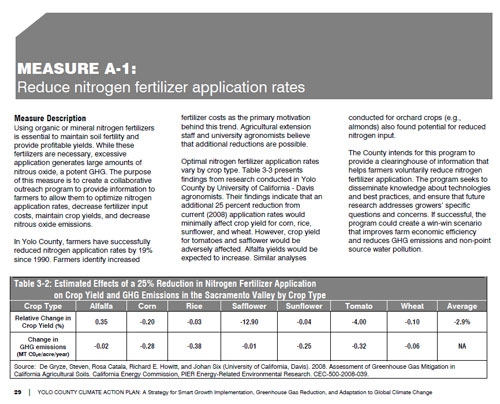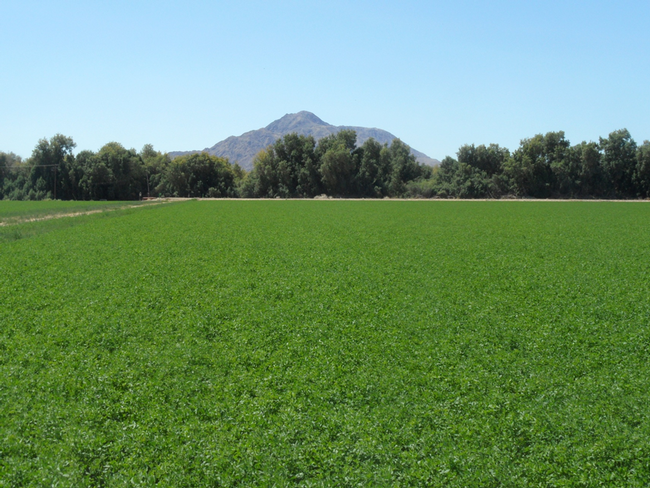Posts Tagged: Dan Putnam
Drip irrigation in alfalfa cuts water use, but isn't for everybody
The drought is forcing farmers to reexamine the way they water their crops, but converting to drip irrigation in alfalfa is unlikely to be widely implemented, reported David Wagner on KPBS Radio News.
The drip irrigation system conserves water - almost by half, said farmer Jack Cato - but is expensive and requires regular maintenance. After six years, the drip system is yet to pay for itself.
"Drip irrigation is not the answer for everything," said Khaled Bali, irrigation advisor with UC Agriculture and Natural Resources (UC ANR). "I would not recommend switching every acre in the Imperial Valley to drip irrigation."
Cato added that new drip irrigation users face a steep learning curve.
"Whatever farm starts doing this, he needs to take baby steps," Cato said. "It's not something you learn overnight, or in a book. You have to study your fields daily."
For more on water use and alfalfa, see Why alfalfa is the best crop to have in the drought by Daniel Putnam, UC ANR Cooperative Extension specialist based at UC Davis, in the Alfalfa & Forage Blog.
Farmers dealing with unwelcome 'snow'
Due to the lingering drought, farms in the San Joaquin Valley are being found with an unwelcome white dusting of "snow" on the soil surface. It isn't the snow so desperately needed in California's high country; rather it is salt and other toxins that have precipitated out of the soil because of sparse winter rains, reported Dennis Pollock in Western Farm Press.
At the recent California Plant and Soil Conference in Fresno, multiple speakers showed pictures of what they labeled "California snow," the article said.
Plant toxins like selenium, boron and salt leach out with water, but water is in short supply this year. "That's why a lot of land is fallow," said Gary Banuelos, USDA-ARS researcher in Parlier.
At the conference, Rick Snyder, UC Cooperative Extension specialist in the Department of Land, Air and Water Resources at UC Davis, said applying less water will reduce deep percolation and could result in higher salinity in the rooting zone. Eventually deficit irrigation will become problematic, especially if practiced over a longterm drought.
Snyder said it might be better to apply available water to a smaller area to maintain production. In the case of permanent crops, he suggested the same frequency of irrigation, but using less water with each application.
David Doll, UCCE farm advisor in Merced County, said almonds are sensitive to high levels of sodium, chloride and boron; and that some rootstocks are more tolerant of saline conditions than others.
Dan Putnam, UCCE specialist in the Department of Plant Sciences at UC Davis, said alfalfa may be capable of tolerating higher salt levels than previously thought.
Some degraded water that could not be used on food crops can be used on alfalfa, he said, adding that alfalfa is in higher demand than many other salt-tolerant plants. While salinity may trigger a decline in percentage of germinated seeds, Putnam said, “that doesn't scare us; we can live with a 40 percent level.”
Blake Sanden, UCCE advisor in Kern County, said there are research gaps with regard to soil toxin tolerance in pistachios.
However, he said, a buildup of boron in the soil is "a potential boron time bomb."
Sanden's research showed a doubling of total boron in the soil after nine years. Without 6 to 10 inches of rainfall or fresh water winter irrigation for leaching every one to two years, he said, high levels of boron could render pistachio production unsustainable.
Water inputs for dairy products outlined by Mother Jones
The Mother Jones website posted a detailed info-graphic to compare the water footprint of milk, other dairy products and dairy alternatives, like soy milk and almond milk.
Reporters Julia Lurie and Alex Park gleaned data for the story from, among other sources, a post in the UC Alfalfa & Forage News Blog titled Alfalfa benefits wildlife and the environment, in addition to its economic value, written in May 2013 by Rachael Freeman Long, UC Cooperative Extension advisor in Yolo County, and Daniel Putnam, UCCE specialist in the Department of Plant Sciences at UC Davis.
The Mother Jones article noted that alfalfa hay is a superfood of sorts for dairy cows — it's high in protein, high in energy and it's digestible.
"When you feed alfalfa, you produce more milk," Putnam and Long wrote in the blog post. "That's the bottom line. The next time you have pizza (with cheese), milk on your cereal, or ice cream, thank alfalfa."
The Mother Jones' info-graphic says it takes 683 gallons of water to produce one gallon of milk.
Yolo County approves Climate Action Plan
The Yolo County Board of Supervisors this week adopted a Climate Action Plan, however, UC Davis Cooperative Extension alfalfa specialist Dan Putnam questioned the part of the plan that deals with reducing fertilizer use, the Davis Enterprise reported.
Yolo County strives to be at the forefront of the "green movement," according to its website. The county's 2030 General Plan included the requirement to develop a Climate Action Plan.
On Page 29 of the 124-page document, the plan says that cutting alfalfa nitrogen fertilizer 25 percent will result in a .35 percent increase in alfalfa yield (see chart below).
“The alfalfa part of that is just wrong — dead wrong,” Putnam was quoted. ”That’s just nonsense. I don’t agree with that at all.”
Putnam said some of the conclusions in the plan could be explained by "the vagaries of nature."
“It’s one thing if the model spits out (a number), and it’s another if it’s something we can measure in the field. It’s another thing to ‘ground truth’ it," according to Putnam.
Supervisor Duane Chamberlain represents the county’s rural areas, farms alfalfa and is one of Putnam's research collaborators. He voted to approve the Climate Action Plan, but was vocal about his concerns over the underlying science, the Enterprise reported.
"I’d like to see some science in here,” Chamberlain was quoted. “The science is terrible. We don’t have any science. We have modeling. This is people who’ve drawn pictures."
The Woodland Daily Democrat also covered the passage of Yolo County's Climate Action Plan.

Yolo County Climate Action Plan
Roundup Ready alfalfa news and a news roundup
Late last month, USDA once again deregulated genetically modified alfalfa. The action prompted extensive news media coverage, with many articles centering on outcry from organic growers who are not comfortable with the idea of GMO/non-GMO coexistence.
According to a DTN blog, UC Davis Cooperative Extension alfalfa specialist Dan Putnam said he doesn't believe the deregulation puts organic alfalfa at risk.
"I don't believe it is certain. I believe it is something we can manage and prevent," he said.
Putnam's research results on alfalfa cross-contamination were noted in a blog on The Atlantic. A 2008 study found that when a Roundup Ready alfalfa seed crop and a non-Roundup Ready hay crop were grown 160 feet apart, the rate of successful gene flow from GM seed crop to non-GM hay crop was 0.25 percent - considered a small risk.
Nevertheless, Putnam said USDA's deregulaton decision likely won't put the controversy to rest.
"There's no question the lawsuits will continue. They would probably continue regardless of whichever way they went," he was quoted.
News roundup
Here are a few news stories that appeared this week that touched on ANR:
Sumo citrus. LA Times freelance food writer David Karp introduced readers to a new citrus variety, the Sumo. "Think of a huge mandarin, easy to peel and seedless, with firm flesh that melts in the mouth, an intense sweetness balanced by refreshing acidity, and a complex, lingering mandarin orange aroma," Karp wrote. "I've tasted more than 1,000 varieties of citrus, and to me the Dekopon (Sumo) is the most delicious." The Citrus Clonal Protection Program at UC Riverside played a role in making the Japanese fruit available to Americans by cleaning imported budwood to be sure it is free of diseases, a process that took several years.
Garden recycling. The L.A. At Home blog in the LA Times outlined ideas for putting recyclables to work in the garden, gleaned from Yvonne Savio, the manager of the LA Master Gardener program. The post illustrates a compost bin made of rusty bedsprings, an old bathtub turned into an ornamental shade garden, aluminum roasting pans that were recycled into seed-starting trays and plastic water bottles that double as water channeling containers.
Cheaters never prosper. In a move aimed at ending cheating at farmers' markets, the CDFA is proposing a significant fee hike for vendors - from 60 cents to $4. The $4 fee would raise about $1.5 million annually, much of which would be used to hire full-time CDFA officers based in Northern, Central and Southern California to conduct farm and market inspections, according to the LA Times.
Creating jobs. The head of USDA's Rural Development office in California visited Santa Cruz County to offer her agency's help to create jobs, said a story in the Santa Cruz Sentinel. "As a nation we have hemorrhaged jobs," said Glenda Humiston. "The jobs we've lost, virtually none of them are coming back." Pointing to positive steps to alleviate the problem, she noted that the Center for Regional Change at UC Davis is studying ways to innovate financial systems to invest local money locally.



